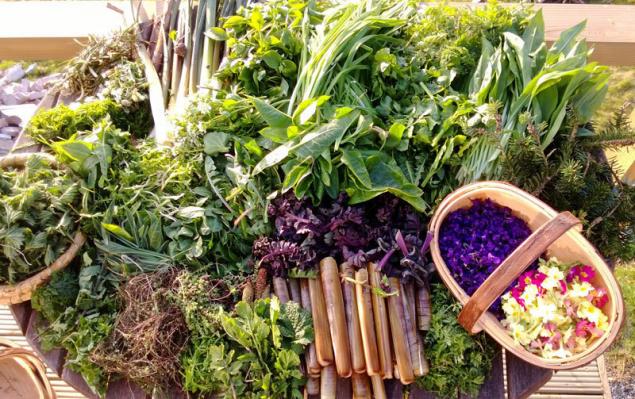825
The incredible benefits of wild plants for your health
Wild plants that grow just beneath his feet, NE just weeds. In using these plants for food, you cleanse and heal your body, prolong youth and beauty of the store.
Goutweed
This storehouse of nutrients. In its greens contain vitamins A, C, proteins, sugars - glucose, fructose, fiber, essential oils, coumarins, flavonoids, malic and citric organic acids, micro and macro elements - magnesium, potassium, manganese, iron, boron, copper, titanium, .
To collect the most food shoots, when the leaf is still light green, shiny and unopened - it is crisp and without a specific taste. Greens goutweed good for boiling - it is put in place of cabbage. Only cook goutweed need a little bit - too gentle.
Also, with "weed" make okroshka kvass or buttermilk, goutweed, chives, dill, cucumber - and a little mustard to severity. The easiest way to prepare goutweed is drying of young leaves, their grinding, sifting through a sieve and use the powder in the winter as a seasoning during cooking.

Burdock
Burdock is not only useful and medicinal plant, but also edible. In Siberia and the Caucasus burdock has long been considered a vegetable plant. In Japan it is grown in the beds, and it is called there --Euclidean.
In the food consumed roots and leaves. But the most popular nutritional burdock root. They are used in baked and fried form; boiled and marinated in China and Japan are considered a delicacy.
The taste of burdock roots resemble potatoes, and can replace it in soups and soup, they willingly eaten raw - they are juicy, sweetish and very pleasant to the taste. From the dried and milled roots get flour from which they bake delicious cakes, fried cutlets. If the roots are crushed, dried and fry, it will be a good substitute for coffee, and if you add lemon, it is possible to cook a delicious jam and serve it to tea.
From young leaves prepare salads and soups.
Quinoa
You can cook porridge of refined quinoa seeds, to taste reminiscent of buckwheat. Or bake cakes, cook mashed potatoes, cakes, casseroles. From young leaves are prepared salads, soup, salad.
Quinoa is marinated, kvass, dried, added to soups. Our ancestors used quinoa not only in times of famine. Quinoa cleanses the body of toxins, due to high content of the plant fiber and pectin, which, like a sponge, absorb toxins from the intestines, excess salt and toxins. Quinoa helps constipation associated with our traditional bread-and-carbohydrate diet.
Nettle
From nettle soup and boiled young leaves are also used in salad. By the way, a lot of nettles silicon and protein, is not inferior to the amount of protein in beans ...
Cyprus or Ivan tea
In the food consumed roots and leaves of the plant. From the roots from which it is made flour tortillas are baked. The leaves can be used in a salad and soup. Well, traditionally tea.
Woodlouse
All aboveground part woodlice edible. 100 g of the mass until it contains 115 mg of vitamin C, carotene 23 mg to 44 mg of vitamin E and high in potassium and chlorine. Woodlice herb used in salads, borscht, soups, mashed potatoes, stuffing for pies and dumplings. At the sight of her eating boiled like spinach ... you can cook pasta carotene of green.
Dandelion
In the food fit all parts of this plant. From the roots can make flour. The roots can be brewed as a "coffee" drink. From young leaves are preparing salads and salad. From flowers desserts. Cook the jam.
Plantain
Plantain leaves are added to salads, tea, beverages, soups and condiments. Unlike other herbs, this plant does not have the stomach laxative effect ...
Dry soup filling of plantain leaves: young leaves are washed, slightly dry in the air, then continue drying first at room temperature in the shade, and then in the oven. Grind in a mortar, sieved through a sieve, put into storage jars. Use for filling soups and boiling.
Fern
It is said that the ancient Slavs used the fern food. For food suitable only two types - a bracken and strausnik. Suitable young shoots. They can be collected in the beginning of May in just a few days. These shoots are boiled for 10 minutes. Water is drained. And then they can cook on your own. Marinate, make salads, frying, etc. The taste they resemble mushrooms.
Wheat grass
This plant is known to many, like a weed. But not many people know about its medicinal properties. For food, you can use the roots of plants.
Flour and cereals of wheat grass
The underground rhizomes branching white wheatgrass dig in early spring, wash in cold water, air dried. Grind to remove the brown scales, grind into flour or grits. In ancient times to make bread and porridge made from this flour.
Hazel (hazelnut)
Hazel Leaves can be used for stuffed cabbage in salads. A nut nuts make vegan "milk".
Goutweed
This storehouse of nutrients. In its greens contain vitamins A, C, proteins, sugars - glucose, fructose, fiber, essential oils, coumarins, flavonoids, malic and citric organic acids, micro and macro elements - magnesium, potassium, manganese, iron, boron, copper, titanium, .
To collect the most food shoots, when the leaf is still light green, shiny and unopened - it is crisp and without a specific taste. Greens goutweed good for boiling - it is put in place of cabbage. Only cook goutweed need a little bit - too gentle.
Also, with "weed" make okroshka kvass or buttermilk, goutweed, chives, dill, cucumber - and a little mustard to severity. The easiest way to prepare goutweed is drying of young leaves, their grinding, sifting through a sieve and use the powder in the winter as a seasoning during cooking.

Burdock
Burdock is not only useful and medicinal plant, but also edible. In Siberia and the Caucasus burdock has long been considered a vegetable plant. In Japan it is grown in the beds, and it is called there --Euclidean.
In the food consumed roots and leaves. But the most popular nutritional burdock root. They are used in baked and fried form; boiled and marinated in China and Japan are considered a delicacy.
The taste of burdock roots resemble potatoes, and can replace it in soups and soup, they willingly eaten raw - they are juicy, sweetish and very pleasant to the taste. From the dried and milled roots get flour from which they bake delicious cakes, fried cutlets. If the roots are crushed, dried and fry, it will be a good substitute for coffee, and if you add lemon, it is possible to cook a delicious jam and serve it to tea.
From young leaves prepare salads and soups.
Quinoa
You can cook porridge of refined quinoa seeds, to taste reminiscent of buckwheat. Or bake cakes, cook mashed potatoes, cakes, casseroles. From young leaves are prepared salads, soup, salad.
Quinoa is marinated, kvass, dried, added to soups. Our ancestors used quinoa not only in times of famine. Quinoa cleanses the body of toxins, due to high content of the plant fiber and pectin, which, like a sponge, absorb toxins from the intestines, excess salt and toxins. Quinoa helps constipation associated with our traditional bread-and-carbohydrate diet.
Nettle
From nettle soup and boiled young leaves are also used in salad. By the way, a lot of nettles silicon and protein, is not inferior to the amount of protein in beans ...
Cyprus or Ivan tea
In the food consumed roots and leaves of the plant. From the roots from which it is made flour tortillas are baked. The leaves can be used in a salad and soup. Well, traditionally tea.
Woodlouse
All aboveground part woodlice edible. 100 g of the mass until it contains 115 mg of vitamin C, carotene 23 mg to 44 mg of vitamin E and high in potassium and chlorine. Woodlice herb used in salads, borscht, soups, mashed potatoes, stuffing for pies and dumplings. At the sight of her eating boiled like spinach ... you can cook pasta carotene of green.
Dandelion
In the food fit all parts of this plant. From the roots can make flour. The roots can be brewed as a "coffee" drink. From young leaves are preparing salads and salad. From flowers desserts. Cook the jam.
Plantain
Plantain leaves are added to salads, tea, beverages, soups and condiments. Unlike other herbs, this plant does not have the stomach laxative effect ...
Dry soup filling of plantain leaves: young leaves are washed, slightly dry in the air, then continue drying first at room temperature in the shade, and then in the oven. Grind in a mortar, sieved through a sieve, put into storage jars. Use for filling soups and boiling.
Fern
It is said that the ancient Slavs used the fern food. For food suitable only two types - a bracken and strausnik. Suitable young shoots. They can be collected in the beginning of May in just a few days. These shoots are boiled for 10 minutes. Water is drained. And then they can cook on your own. Marinate, make salads, frying, etc. The taste they resemble mushrooms.
Wheat grass
This plant is known to many, like a weed. But not many people know about its medicinal properties. For food, you can use the roots of plants.
Flour and cereals of wheat grass
The underground rhizomes branching white wheatgrass dig in early spring, wash in cold water, air dried. Grind to remove the brown scales, grind into flour or grits. In ancient times to make bread and porridge made from this flour.
Hazel (hazelnut)
Hazel Leaves can be used for stuffed cabbage in salads. A nut nuts make vegan "milk".
























